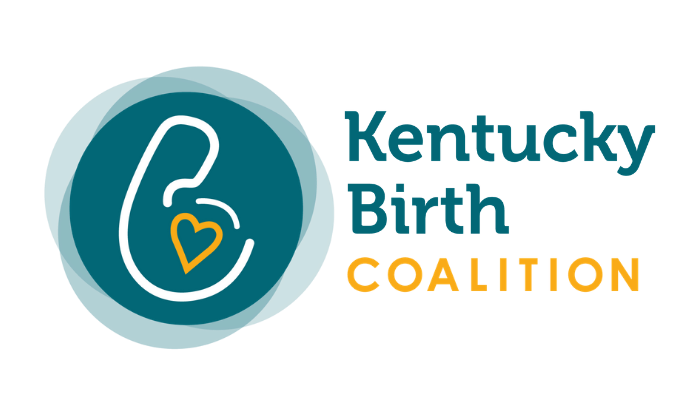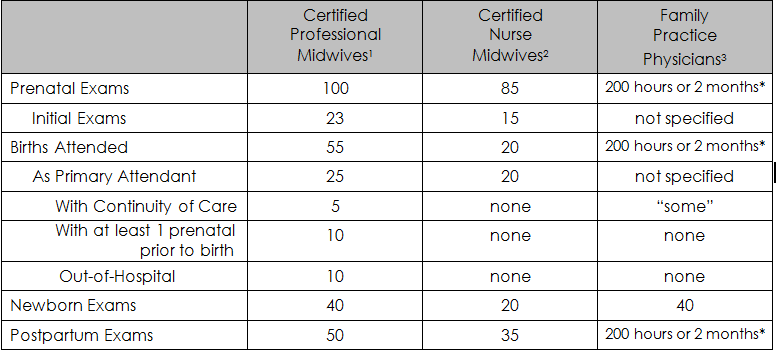The Certified Professional Midwife Credential
The Certified Professional Midwife credential, issued by the North American Registry of Midwives (NARM), is accredited by the National Commission for Certifying Agencies (NCCA), the accrediting body of the Institute for Credentialing Excellence (ICE, formerly NOCA). The mission of ICE is to promote excellence in credentialing for practitioners in all occupations and professions. The NCCA accredits many healthcare credentials, including the Certified Nurse-Midwife (CNM). The CPM is the only NCCA-accredited midwifery credential that includes a requirement for out-of-hospital experience.(1)
The credentialing process has two distinct components: education and certification. The educational portion includes a specified clinical component that must be performed under the supervision of a preceptor who verifies that the student can perform the skills, and exhibits the knowledge necessary for the safe, independent practice of midwifery. The certification verification is comprised of an extensive Written Examination that encompasses the essential body of knowledge and skills necessary for safe and competent entry-level, out of hospital midwifery practice.(2)
The educational portion of the CPM can be completed in three ways:
- Graduation from a Midwifery Education Accreditation Council (MEAC) or American Midwifery Certification Board (AMCB) accredited program;
- Through legal recognition from a state or province that has been evaluated for educational equivalency from NARM; or
- Through the Portfolio Evaluation Process (PEP).
The PEP application carefully evaluates education through apprenticeship, special circumstances, or international programs, and includes verification of supervised experience. All candidates must have their education validated by one of the above routes before proceeding to the Certification Examination (the NARM Written Examination).(2)
US MERA
Kentucky’s CPM licensing law specifies that educational requirements shall be consistent with the US MERA statement on the licensure of Certified Professional Midwives. US MERA stands for United States Midwifery, Education, Regulation, and Association and is a collaboration of the major national organizations representing education, regulation/certification, and professional association for midwifery. It includes CNM and CPM organizations.
The US MERA statement on the licensure of Certified Professional Midwives establishes the following criteria:
- CPMs who obtain certification after January 1, 2020 will be required to have completed an educational program accredited by the Midwifery Education Accreditation Council (MEAC).
- For CPMs who obtained certification through an educational pathway not accredited by MEAC:
- CPMs certified before January 1, 2020, through a non-accredited pathway will be required to obtain the Midwifery Bridge Certificate issued by NARM in order to apply for licensure, or
- CPMs who have maintained licensure in a state that does not require an accredited education may obtain the Midwifery Bridge Certificate regardless of the date of their certification in order to apply for licensure.
MEAC Accredited Midwifery Programs
The Midwifery Education Accreditation Council (MEAC) establishes standards for the education of competent midwives. The U.S. Department of Education recognizes MEAC as a national accrediting agency for direct-entry midwifery education programs and institutions. Institutions and programs accredited by MEAC provide the student with the academic and clinical requirements to qualify for the NARM Written Examination leading to certification as a CPM.(3)
MEAC accredited programs include residency-based programs and programs that incorporate distance education with residency and local components. This combination approach is utilized by many professional fields and institutions, including Frontier Nursing University, the prominent school in Versailles, KY that educates Certified Nurse Midwives.
All MEAC accredited programs must demonstrate the same curricular requirements for essential competencies.
Midwifery Bridge Certificate
NARM, in collaboration with the US Department of Education (USDE) accredited education programs and US MERA professional organizations, will administer and award the Midwifery Bridge Certificate to CPMs based on completion of 50 accredited approved continuing education contact hours (CEUs/CMEs/CNEs) within the five-year period prior to application. Required continuing education will be based upon identified areas to address emergency skills and the International Confederation of Midwives (ICM) competencies. The list of approved continuing education will be maintained by NARM and regularly evaluated and updated.(4)
The contact hours leading to the Midwifery Bridge Certificate must include a minimum in each of the following three categories:
- Category 1: Emergency Skills in Pregnancy, Birth, and the Immediate Postpartum
- Category 2: Emergency Skills for Newborn Care
- Category 3: Specific Topics Relevant to Midwifery Care
Courses must be accredited and must fit into these categories. CEUs must have been granted by an accrediting organization such as MEAC, ACOG, ACNM, AWHON, AAFP, State Health Depts., Nursing or Perinatal Associations, etc.
Clinical Experience Comparison
The goal of all these providers is to care for women experiencing normal full-term pregnancies with as little intervention as possible; all interventions carry some risks. They continually assess women in their care, identifying any whose pregnancies or births become high risk and transferring their care to an Obstetrician.
*200 hours are spread out between all three parts of care. Family Practice Residents “must document 200 hours (or two months) dedicated to participating in deliveries and providing prenatal and post-partum care”
[1] North American Registry of Midwives Certified Professional Midwife Eligibility Requirement Update, effective September 1, 2012.[2] Accreditation Commission for Midwifery Education Criteria for Programmatic Accreditation of Midwifery Education Programs with Instructions for Elaboration and Documentation, Revised April 2015.
[3] Accreditation Council for Graduate Medical Education. ACGME Program Requirements for Graduate Medical Education in Family Medicine, Effective July 1, 2016.
Clinical & Didactic Experience of a Student Midwife
The following totals represent the training experience of a Student Midwife in Kentucky. She began apprenticing and studying midwifery in May of 2012. In September of 2016, after completing all educational requirements, the student sat for and passed the NARM exam. She is now practicing as a CPM.
Clinical Experience
- 154 births attended
- 16 observed hospital births and/or as doula
- 93 births as beginning apprentice/assistant at birth
- 45 births as primary caregiver under supervision of senior midwife
Prenatal and Postpartum Exams
- 211 prenatals as beginning apprentice/assistant
- 411 prenatals as primary caregiver under supervision of senior midwife
- 103 postpartum visits as beginning apprentice/assistant
- 138 postpartum visits as primary caregiver under supervision of senior midwife
Clinical hours: 2,020 (Births, prenatals, postpartum, consultations)
Approx. 372 hours of in-person interaction with preceptors outside of clinical hours which included, but was not limited to:
- Verifying student’s academical knowledge
- Verifying student’s ability to perform skills
- Personal instruction
- Tailored classes of skills according to student’s learning needs
- Debriefing births
- Discussion of client’s care – current pregnancy or postpartum issues and correct management
Midwifery related texts studied
- Medical Terminology w/ Human Anatomy
- Varney’s Midwifery
- Maternal & Newborn Nursing
- Human Labor & Birth
- A Midwife’s Handbook
- Heart & Hands
- Birth Emergency Skills Training
- Holistic Midwifery, vol 1
- Bate’s Guide to Physical Examinations
- Midwifery Workbook
- Neonatal Resuscitation Textbook
- Examination of the Newborn
- Prescription for Dietary Wellness
- The Naturally Healthy Pregnancy
- Easing Labor Pain
- Active Birth
- Ina May’s Guide to Natural Childbirth
- Ina May’s Guide to Breastfeeding
- Complete Book of Pregnancy and Childbirth
- Natural Childbirth the Bradley Way
- Special Delivery
- The Cooperative Method of Natural Birth Control
- When Survivors Give Birth
- The Ministry of Midwifery
- The Belly Mapping Workbook
Academic study hours: 1,154.5
Academic hours includes
- Workshops pertaining to midwifery care and/or foundational health care
- Studies under the direction of a distance-based midwifery program (homework, quizzes, tests)
- Assigned coursework from preceptors
- Self-directed studies

